Effective Communication Importance
VerifiedAdded on 2020/07/22
|10
|2380
|57
AI Summary
The provided assignment emphasizes the significance of effective communication in a business setting. It covers various aspects such as making positive reactions to confirm understanding, identifying meaning and implication of information, and responding appropriately to situations. The document also touches on the importance of body language, particularly eye contact, in communication. Effective communication is essential for the growth and development of an organization, enabling it to increase its profit-sharing ratio.
Contribute Materials
Your contribution can guide someone’s learning journey. Share your
documents today.
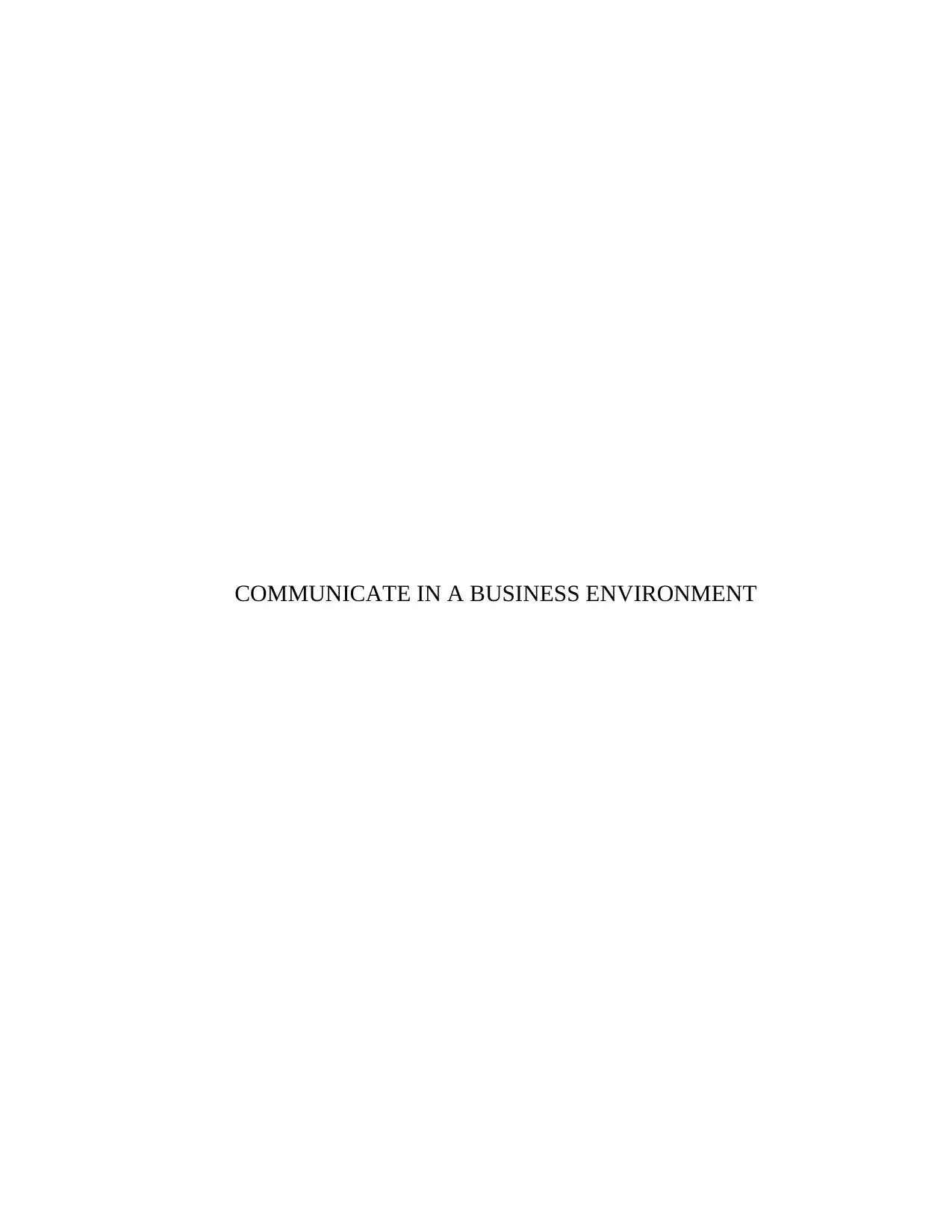
COMMUNICATE IN A BUSINESS ENVIRONMENT
Secure Best Marks with AI Grader
Need help grading? Try our AI Grader for instant feedback on your assignments.
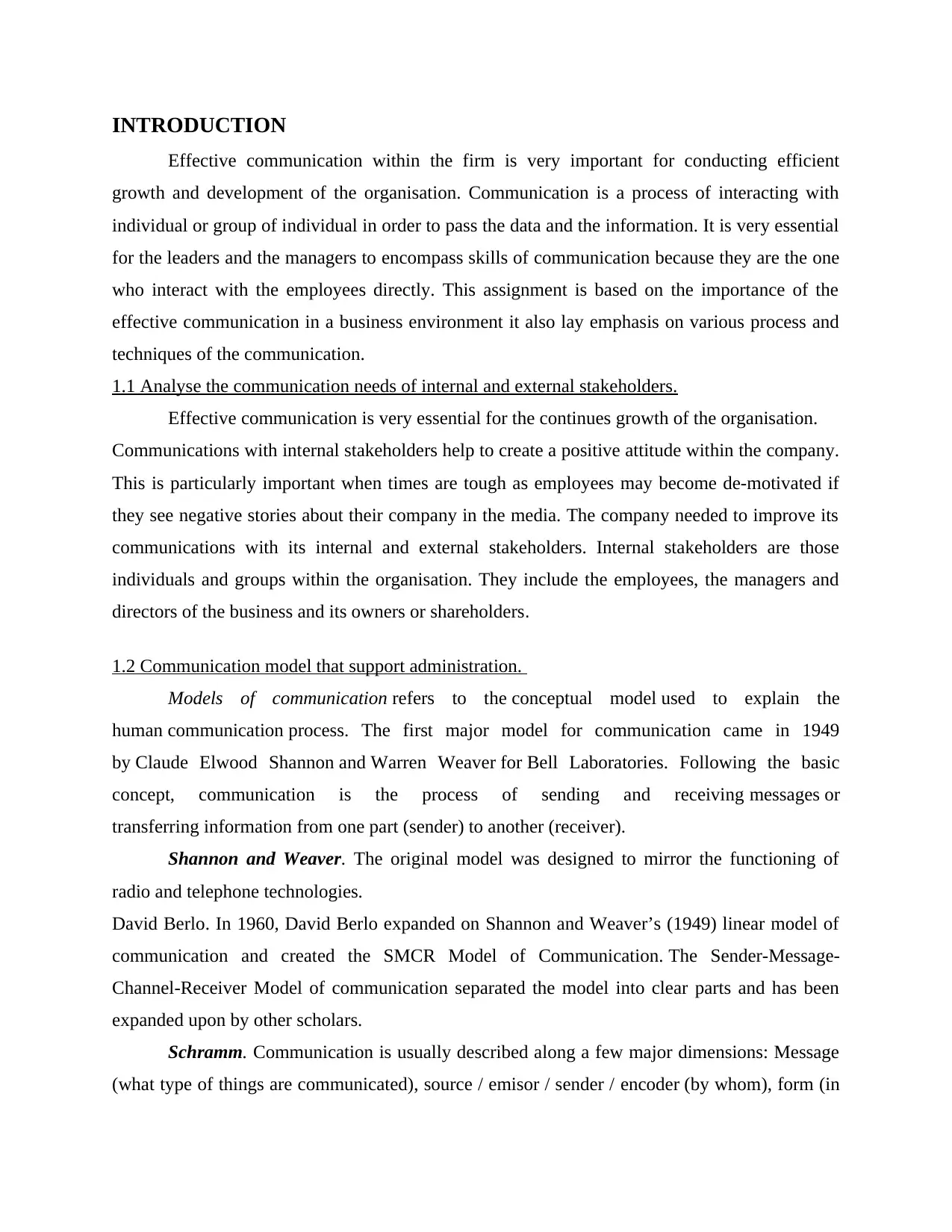
INTRODUCTION
Effective communication within the firm is very important for conducting efficient
growth and development of the organisation. Communication is a process of interacting with
individual or group of individual in order to pass the data and the information. It is very essential
for the leaders and the managers to encompass skills of communication because they are the one
who interact with the employees directly. This assignment is based on the importance of the
effective communication in a business environment it also lay emphasis on various process and
techniques of the communication.
1.1 Analyse the communication needs of internal and external stakeholders.
Effective communication is very essential for the continues growth of the organisation.
Communications with internal stakeholders help to create a positive attitude within the company.
This is particularly important when times are tough as employees may become de-motivated if
they see negative stories about their company in the media. The company needed to improve its
communications with its internal and external stakeholders. Internal stakeholders are those
individuals and groups within the organisation. They include the employees, the managers and
directors of the business and its owners or shareholders.
1.2 Communication model that support administration.
Models of communication refers to the conceptual model used to explain the
human communication process. The first major model for communication came in 1949
by Claude Elwood Shannon and Warren Weaver for Bell Laboratories. Following the basic
concept, communication is the process of sending and receiving messages or
transferring information from one part (sender) to another (receiver).
Shannon and Weaver. The original model was designed to mirror the functioning of
radio and telephone technologies.
David Berlo. In 1960, David Berlo expanded on Shannon and Weaver’s (1949) linear model of
communication and created the SMCR Model of Communication. The Sender-Message-
Channel-Receiver Model of communication separated the model into clear parts and has been
expanded upon by other scholars.
Schramm. Communication is usually described along a few major dimensions: Message
(what type of things are communicated), source / emisor / sender / encoder (by whom), form (in
Effective communication within the firm is very important for conducting efficient
growth and development of the organisation. Communication is a process of interacting with
individual or group of individual in order to pass the data and the information. It is very essential
for the leaders and the managers to encompass skills of communication because they are the one
who interact with the employees directly. This assignment is based on the importance of the
effective communication in a business environment it also lay emphasis on various process and
techniques of the communication.
1.1 Analyse the communication needs of internal and external stakeholders.
Effective communication is very essential for the continues growth of the organisation.
Communications with internal stakeholders help to create a positive attitude within the company.
This is particularly important when times are tough as employees may become de-motivated if
they see negative stories about their company in the media. The company needed to improve its
communications with its internal and external stakeholders. Internal stakeholders are those
individuals and groups within the organisation. They include the employees, the managers and
directors of the business and its owners or shareholders.
1.2 Communication model that support administration.
Models of communication refers to the conceptual model used to explain the
human communication process. The first major model for communication came in 1949
by Claude Elwood Shannon and Warren Weaver for Bell Laboratories. Following the basic
concept, communication is the process of sending and receiving messages or
transferring information from one part (sender) to another (receiver).
Shannon and Weaver. The original model was designed to mirror the functioning of
radio and telephone technologies.
David Berlo. In 1960, David Berlo expanded on Shannon and Weaver’s (1949) linear model of
communication and created the SMCR Model of Communication. The Sender-Message-
Channel-Receiver Model of communication separated the model into clear parts and has been
expanded upon by other scholars.
Schramm. Communication is usually described along a few major dimensions: Message
(what type of things are communicated), source / emisor / sender / encoder (by whom), form (in

which form), channel (through which medium), destination / receiver / target /decoder (to
whom), and Receiver. Wilbur Schramm (1954) also indicated that we should also examine the
impact that a message has (both desired and undesired) on the target of the message.
Psychology of communication. Bernard Luskin, UCLA, 1970, advanced computer
assisted instruction and began to connect media and psychology into what is now the field of
media psychology.
Constructionist Model. There is an additional working definition of communication to
consider that authors like Richard A. Lanham (2003) and as far back as Erving Goffman (1959)
have highlighted. This is a progression from Lasswell’s attempt to define human communication
through to this century and revolutionized into the constructionist model. Constructionists
believe that the process of communication is in itself the only messages that exist.
1.3 Effectiveness of different communication system.
An effective communications system can impact your company's bottom line in several
ways. Your internal communications can let your workforce know what's expected of them,
leading to a more engaged staff. Communicating your value proposition to customers and
investors helps increase sales and keeps those responsible for funding your operations happy.
Different types of communication system are :
Internal communication
External communication
Communicating with investors
Crisis Management
1.4 Factors that effect the choice of communication media.
Source
Growth
Creativity
Skillfulness
Innovations
Objectives
1.5 Importance of using correct grammar, sentence structure and punctuation in communication.
Effective communication is an integral aspect for any business setup. Management and staff
often keep each other updated with the latest reports and news pertaining to the business, and
whom), and Receiver. Wilbur Schramm (1954) also indicated that we should also examine the
impact that a message has (both desired and undesired) on the target of the message.
Psychology of communication. Bernard Luskin, UCLA, 1970, advanced computer
assisted instruction and began to connect media and psychology into what is now the field of
media psychology.
Constructionist Model. There is an additional working definition of communication to
consider that authors like Richard A. Lanham (2003) and as far back as Erving Goffman (1959)
have highlighted. This is a progression from Lasswell’s attempt to define human communication
through to this century and revolutionized into the constructionist model. Constructionists
believe that the process of communication is in itself the only messages that exist.
1.3 Effectiveness of different communication system.
An effective communications system can impact your company's bottom line in several
ways. Your internal communications can let your workforce know what's expected of them,
leading to a more engaged staff. Communicating your value proposition to customers and
investors helps increase sales and keeps those responsible for funding your operations happy.
Different types of communication system are :
Internal communication
External communication
Communicating with investors
Crisis Management
1.4 Factors that effect the choice of communication media.
Source
Growth
Creativity
Skillfulness
Innovations
Objectives
1.5 Importance of using correct grammar, sentence structure and punctuation in communication.
Effective communication is an integral aspect for any business setup. Management and staff
often keep each other updated with the latest reports and news pertaining to the business, and
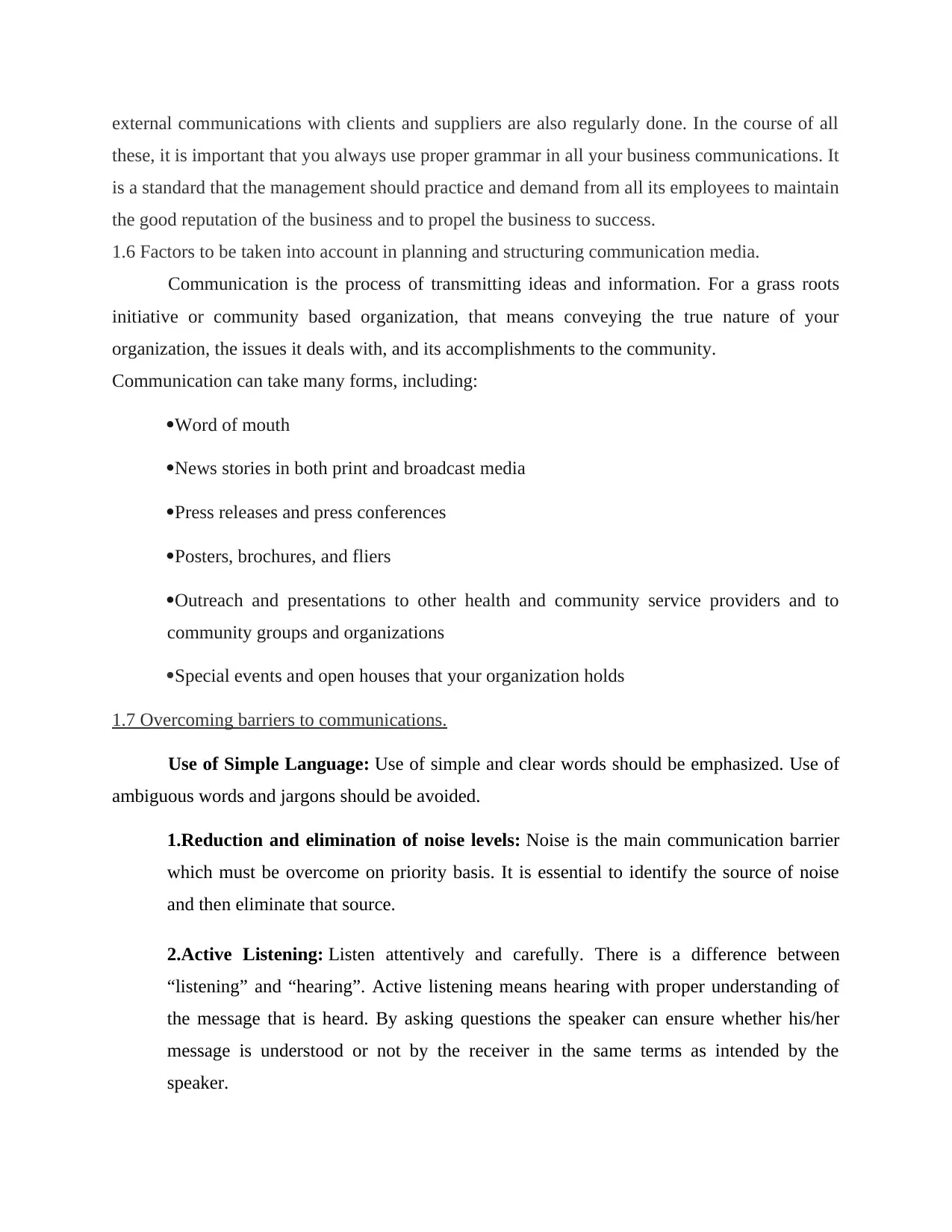
external communications with clients and suppliers are also regularly done. In the course of all
these, it is important that you always use proper grammar in all your business communications. It
is a standard that the management should practice and demand from all its employees to maintain
the good reputation of the business and to propel the business to success.
1.6 Factors to be taken into account in planning and structuring communication media.
Communication is the process of transmitting ideas and information. For a grass roots
initiative or community based organization, that means conveying the true nature of your
organization, the issues it deals with, and its accomplishments to the community.
Communication can take many forms, including:
Word of mouth
News stories in both print and broadcast media
Press releases and press conferences
Posters, brochures, and fliers
Outreach and presentations to other health and community service providers and to
community groups and organizations
Special events and open houses that your organization holds
1.7 Overcoming barriers to communications.
Use of Simple Language: Use of simple and clear words should be emphasized. Use of
ambiguous words and jargons should be avoided.
1.Reduction and elimination of noise levels: Noise is the main communication barrier
which must be overcome on priority basis. It is essential to identify the source of noise
and then eliminate that source.
2.Active Listening: Listen attentively and carefully. There is a difference between
“listening” and “hearing”. Active listening means hearing with proper understanding of
the message that is heard. By asking questions the speaker can ensure whether his/her
message is understood or not by the receiver in the same terms as intended by the
speaker.
these, it is important that you always use proper grammar in all your business communications. It
is a standard that the management should practice and demand from all its employees to maintain
the good reputation of the business and to propel the business to success.
1.6 Factors to be taken into account in planning and structuring communication media.
Communication is the process of transmitting ideas and information. For a grass roots
initiative or community based organization, that means conveying the true nature of your
organization, the issues it deals with, and its accomplishments to the community.
Communication can take many forms, including:
Word of mouth
News stories in both print and broadcast media
Press releases and press conferences
Posters, brochures, and fliers
Outreach and presentations to other health and community service providers and to
community groups and organizations
Special events and open houses that your organization holds
1.7 Overcoming barriers to communications.
Use of Simple Language: Use of simple and clear words should be emphasized. Use of
ambiguous words and jargons should be avoided.
1.Reduction and elimination of noise levels: Noise is the main communication barrier
which must be overcome on priority basis. It is essential to identify the source of noise
and then eliminate that source.
2.Active Listening: Listen attentively and carefully. There is a difference between
“listening” and “hearing”. Active listening means hearing with proper understanding of
the message that is heard. By asking questions the speaker can ensure whether his/her
message is understood or not by the receiver in the same terms as intended by the
speaker.
Secure Best Marks with AI Grader
Need help grading? Try our AI Grader for instant feedback on your assignments.
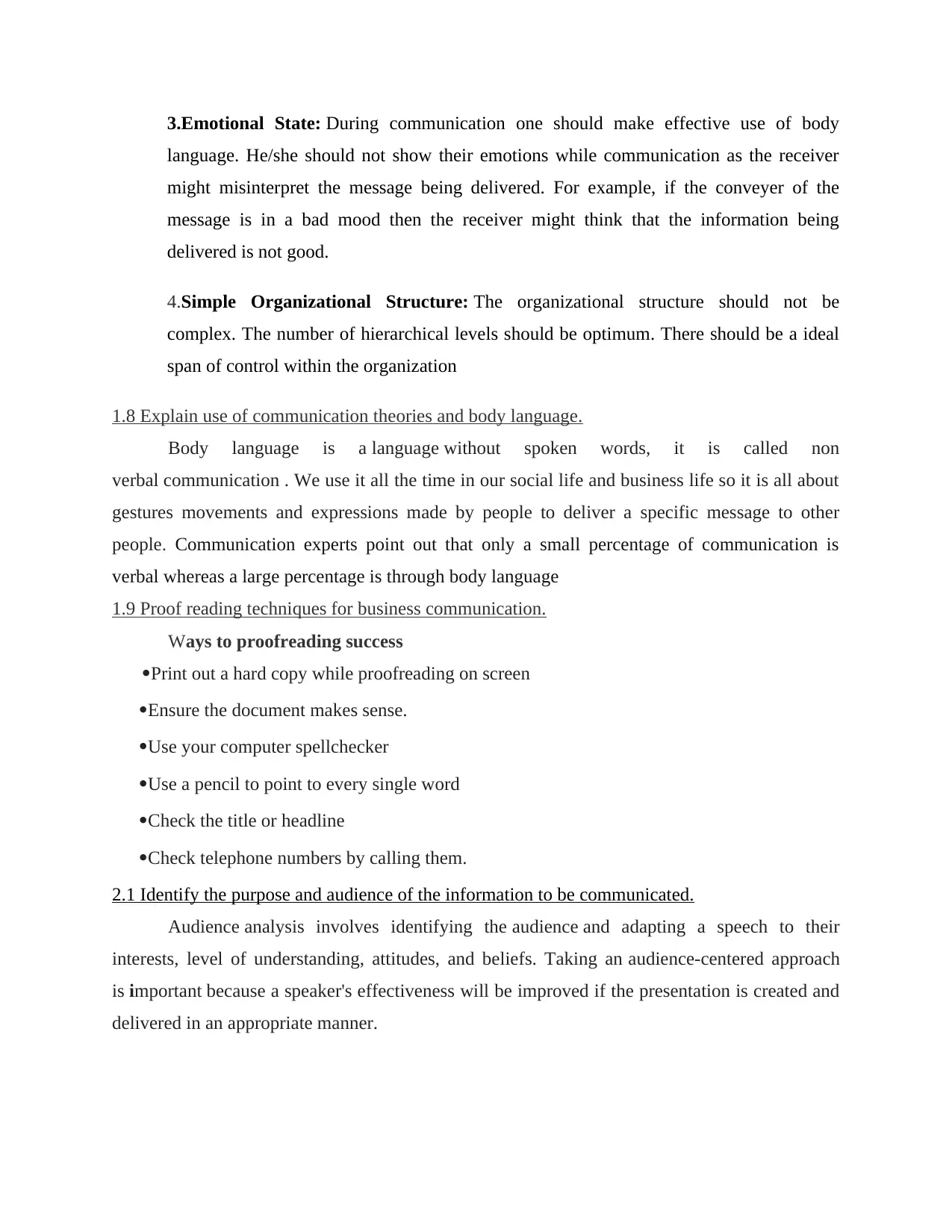
3.Emotional State: During communication one should make effective use of body
language. He/she should not show their emotions while communication as the receiver
might misinterpret the message being delivered. For example, if the conveyer of the
message is in a bad mood then the receiver might think that the information being
delivered is not good.
4.Simple Organizational Structure: The organizational structure should not be
complex. The number of hierarchical levels should be optimum. There should be a ideal
span of control within the organization
1.8 Explain use of communication theories and body language.
Body language is a language without spoken words, it is called non
verbal communication . We use it all the time in our social life and business life so it is all about
gestures movements and expressions made by people to deliver a specific message to other
people. Communication experts point out that only a small percentage of communication is
verbal whereas a large percentage is through body language
1.9 Proof reading techniques for business communication.
Ways to proofreading success
Print out a hard copy while proofreading on screen
Ensure the document makes sense.
Use your computer spellchecker
Use a pencil to point to every single word
Check the title or headline
Check telephone numbers by calling them.
2.1 Identify the purpose and audience of the information to be communicated.
Audience analysis involves identifying the audience and adapting a speech to their
interests, level of understanding, attitudes, and beliefs. Taking an audience-centered approach
is important because a speaker's effectiveness will be improved if the presentation is created and
delivered in an appropriate manner.
language. He/she should not show their emotions while communication as the receiver
might misinterpret the message being delivered. For example, if the conveyer of the
message is in a bad mood then the receiver might think that the information being
delivered is not good.
4.Simple Organizational Structure: The organizational structure should not be
complex. The number of hierarchical levels should be optimum. There should be a ideal
span of control within the organization
1.8 Explain use of communication theories and body language.
Body language is a language without spoken words, it is called non
verbal communication . We use it all the time in our social life and business life so it is all about
gestures movements and expressions made by people to deliver a specific message to other
people. Communication experts point out that only a small percentage of communication is
verbal whereas a large percentage is through body language
1.9 Proof reading techniques for business communication.
Ways to proofreading success
Print out a hard copy while proofreading on screen
Ensure the document makes sense.
Use your computer spellchecker
Use a pencil to point to every single word
Check the title or headline
Check telephone numbers by calling them.
2.1 Identify the purpose and audience of the information to be communicated.
Audience analysis involves identifying the audience and adapting a speech to their
interests, level of understanding, attitudes, and beliefs. Taking an audience-centered approach
is important because a speaker's effectiveness will be improved if the presentation is created and
delivered in an appropriate manner.
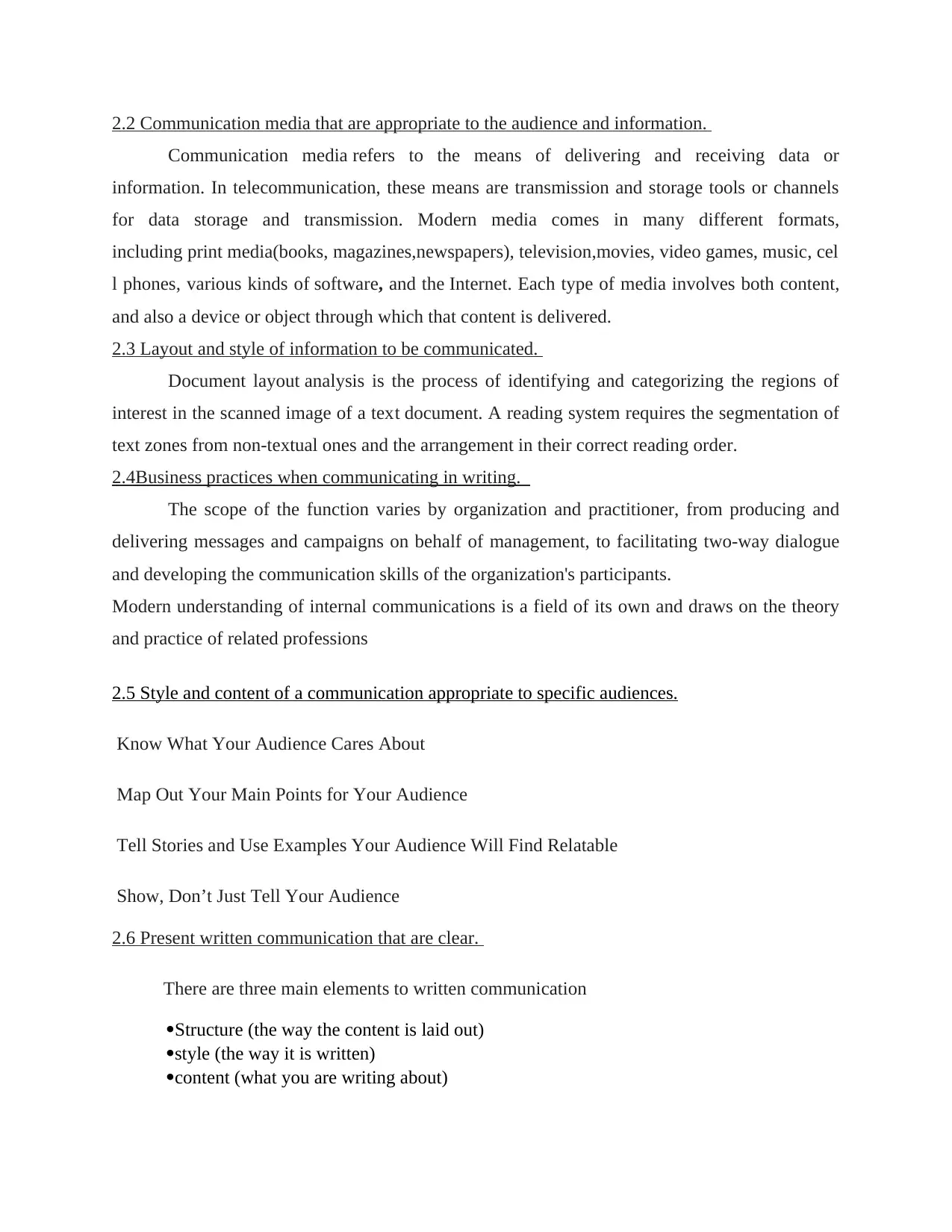
2.2 Communication media that are appropriate to the audience and information.
Communication media refers to the means of delivering and receiving data or
information. In telecommunication, these means are transmission and storage tools or channels
for data storage and transmission. Modern media comes in many different formats,
including print media(books, magazines,newspapers), television,movies, video games, music, cel
l phones, various kinds of software, and the Internet. Each type of media involves both content,
and also a device or object through which that content is delivered.
2.3 Layout and style of information to be communicated.
Document layout analysis is the process of identifying and categorizing the regions of
interest in the scanned image of a text document. A reading system requires the segmentation of
text zones from non-textual ones and the arrangement in their correct reading order.
2.4Business practices when communicating in writing.
The scope of the function varies by organization and practitioner, from producing and
delivering messages and campaigns on behalf of management, to facilitating two-way dialogue
and developing the communication skills of the organization's participants.
Modern understanding of internal communications is a field of its own and draws on the theory
and practice of related professions
2.5 Style and content of a communication appropriate to specific audiences.
Know What Your Audience Cares About
Map Out Your Main Points for Your Audience
Tell Stories and Use Examples Your Audience Will Find Relatable
Show, Don’t Just Tell Your Audience
2.6 Present written communication that are clear.
There are three main elements to written communication
Structure (the way the content is laid out)
style (the way it is written)
content (what you are writing about)
Communication media refers to the means of delivering and receiving data or
information. In telecommunication, these means are transmission and storage tools or channels
for data storage and transmission. Modern media comes in many different formats,
including print media(books, magazines,newspapers), television,movies, video games, music, cel
l phones, various kinds of software, and the Internet. Each type of media involves both content,
and also a device or object through which that content is delivered.
2.3 Layout and style of information to be communicated.
Document layout analysis is the process of identifying and categorizing the regions of
interest in the scanned image of a text document. A reading system requires the segmentation of
text zones from non-textual ones and the arrangement in their correct reading order.
2.4Business practices when communicating in writing.
The scope of the function varies by organization and practitioner, from producing and
delivering messages and campaigns on behalf of management, to facilitating two-way dialogue
and developing the communication skills of the organization's participants.
Modern understanding of internal communications is a field of its own and draws on the theory
and practice of related professions
2.5 Style and content of a communication appropriate to specific audiences.
Know What Your Audience Cares About
Map Out Your Main Points for Your Audience
Tell Stories and Use Examples Your Audience Will Find Relatable
Show, Don’t Just Tell Your Audience
2.6 Present written communication that are clear.
There are three main elements to written communication
Structure (the way the content is laid out)
style (the way it is written)
content (what you are writing about)
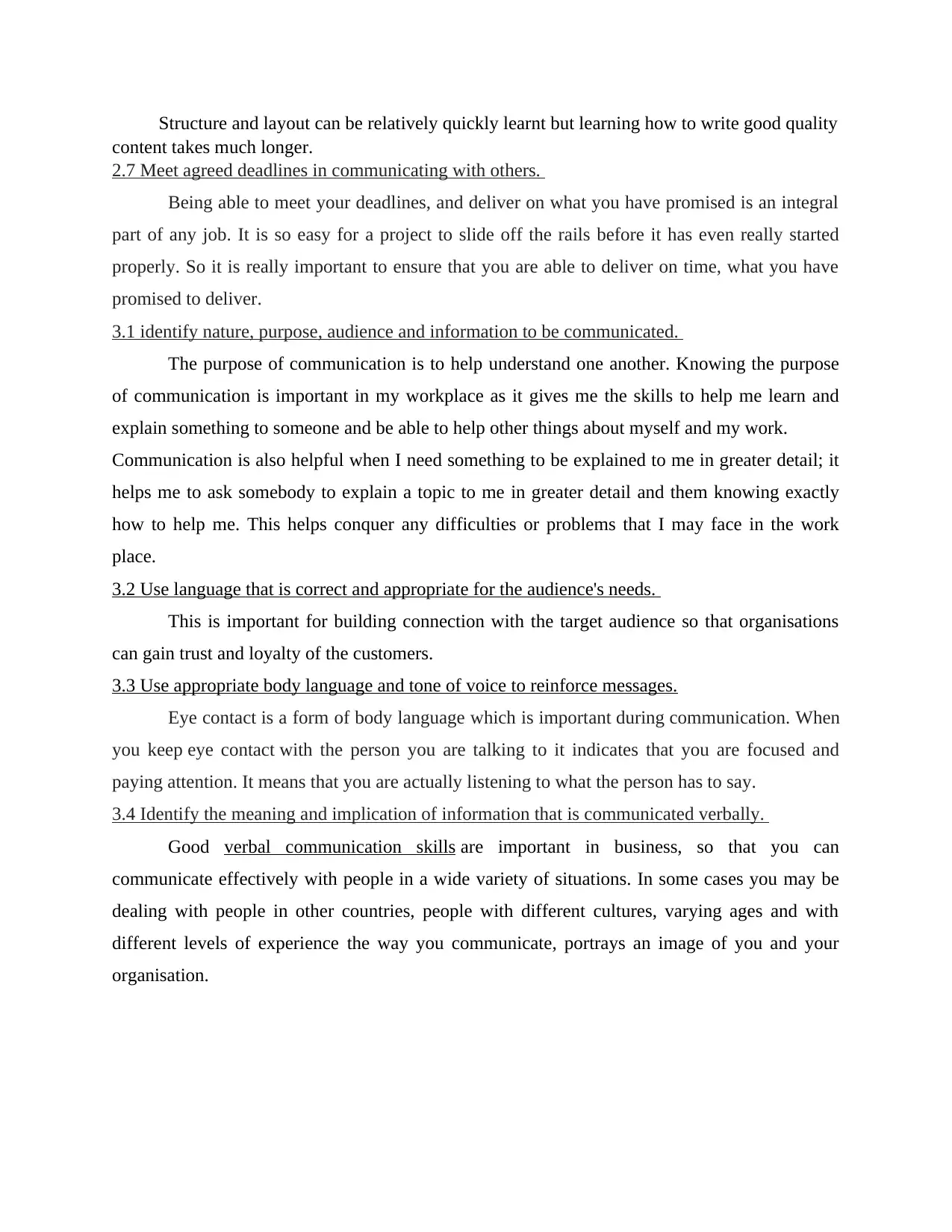
Structure and layout can be relatively quickly learnt but learning how to write good quality
content takes much longer.
2.7 Meet agreed deadlines in communicating with others.
Being able to meet your deadlines, and deliver on what you have promised is an integral
part of any job. It is so easy for a project to slide off the rails before it has even really started
properly. So it is really important to ensure that you are able to deliver on time, what you have
promised to deliver.
3.1 identify nature, purpose, audience and information to be communicated.
The purpose of communication is to help understand one another. Knowing the purpose
of communication is important in my workplace as it gives me the skills to help me learn and
explain something to someone and be able to help other things about myself and my work.
Communication is also helpful when I need something to be explained to me in greater detail; it
helps me to ask somebody to explain a topic to me in greater detail and them knowing exactly
how to help me. This helps conquer any difficulties or problems that I may face in the work
place.
3.2 Use language that is correct and appropriate for the audience's needs.
This is important for building connection with the target audience so that organisations
can gain trust and loyalty of the customers.
3.3 Use appropriate body language and tone of voice to reinforce messages.
Eye contact is a form of body language which is important during communication. When
you keep eye contact with the person you are talking to it indicates that you are focused and
paying attention. It means that you are actually listening to what the person has to say.
3.4 Identify the meaning and implication of information that is communicated verbally.
Good verbal communication skills are important in business, so that you can
communicate effectively with people in a wide variety of situations. In some cases you may be
dealing with people in other countries, people with different cultures, varying ages and with
different levels of experience the way you communicate, portrays an image of you and your
organisation.
content takes much longer.
2.7 Meet agreed deadlines in communicating with others.
Being able to meet your deadlines, and deliver on what you have promised is an integral
part of any job. It is so easy for a project to slide off the rails before it has even really started
properly. So it is really important to ensure that you are able to deliver on time, what you have
promised to deliver.
3.1 identify nature, purpose, audience and information to be communicated.
The purpose of communication is to help understand one another. Knowing the purpose
of communication is important in my workplace as it gives me the skills to help me learn and
explain something to someone and be able to help other things about myself and my work.
Communication is also helpful when I need something to be explained to me in greater detail; it
helps me to ask somebody to explain a topic to me in greater detail and them knowing exactly
how to help me. This helps conquer any difficulties or problems that I may face in the work
place.
3.2 Use language that is correct and appropriate for the audience's needs.
This is important for building connection with the target audience so that organisations
can gain trust and loyalty of the customers.
3.3 Use appropriate body language and tone of voice to reinforce messages.
Eye contact is a form of body language which is important during communication. When
you keep eye contact with the person you are talking to it indicates that you are focused and
paying attention. It means that you are actually listening to what the person has to say.
3.4 Identify the meaning and implication of information that is communicated verbally.
Good verbal communication skills are important in business, so that you can
communicate effectively with people in a wide variety of situations. In some cases you may be
dealing with people in other countries, people with different cultures, varying ages and with
different levels of experience the way you communicate, portrays an image of you and your
organisation.
Paraphrase This Document
Need a fresh take? Get an instant paraphrase of this document with our AI Paraphraser

3.5 Confirm that a recipient has understood correctly what has been communicated.
Positive reactions given by the audience stated that they understood correctly the
information that has been passed to them.
3.6 Respond in a way that is appropriate to the situation
Effective communication is important for the effective growth and development of the
organisation in order to increase its profit sharing ratio.
CONCLUSION
From the above assignment it can be concluded that effective communication is very
important for the growth and development of the organisation.
REFERENCES
Books and Journals
Argenti, P.A., 2015. Corporate communication. McGraw-Hill Higher Education.
Bovée, C.L. and Thill, J.V., 2012. Excellence in business communication. Pearson Higher Ed.
Connor, S.R., Jackson, J.W. and Kuczynski, J., International Business Machines Corp,
2017. Multicultural communication management. 15(4). pp.19-39.
Hamilton, L. and Webster, P., 2015. The international business environment. Oxford University
Press, USA.
Hansen, A., 2010. Environment, media and communication. Routledge.
Kew, J. and Stredwick, J., 2017. Business environment: managing in a strategic context. Kogan
Page Publishers.
Luo, Y. and Bu, J., 2016. How valuable is information and communication technology? A study
of emerging economy enterprises. Journal of World Business, 51(2). pp.200-211.
Morita, K. and et.al., 2017. Communication apparatus, communication system, and
communication management system. 45(8). pp.26-49.
Niemann-Struweg, I., 2014. An integrated communication implementation model for the post-
2000 business environment. Public Relations Review. 40(2). pp.184-192.
Popescu, G.H., 2013. Macroeconomics, effective leadership, and the global business
environment. Contemporary Readings in Law and Social Justice. 5(2). p.170.
Positive reactions given by the audience stated that they understood correctly the
information that has been passed to them.
3.6 Respond in a way that is appropriate to the situation
Effective communication is important for the effective growth and development of the
organisation in order to increase its profit sharing ratio.
CONCLUSION
From the above assignment it can be concluded that effective communication is very
important for the growth and development of the organisation.
REFERENCES
Books and Journals
Argenti, P.A., 2015. Corporate communication. McGraw-Hill Higher Education.
Bovée, C.L. and Thill, J.V., 2012. Excellence in business communication. Pearson Higher Ed.
Connor, S.R., Jackson, J.W. and Kuczynski, J., International Business Machines Corp,
2017. Multicultural communication management. 15(4). pp.19-39.
Hamilton, L. and Webster, P., 2015. The international business environment. Oxford University
Press, USA.
Hansen, A., 2010. Environment, media and communication. Routledge.
Kew, J. and Stredwick, J., 2017. Business environment: managing in a strategic context. Kogan
Page Publishers.
Luo, Y. and Bu, J., 2016. How valuable is information and communication technology? A study
of emerging economy enterprises. Journal of World Business, 51(2). pp.200-211.
Morita, K. and et.al., 2017. Communication apparatus, communication system, and
communication management system. 45(8). pp.26-49.
Niemann-Struweg, I., 2014. An integrated communication implementation model for the post-
2000 business environment. Public Relations Review. 40(2). pp.184-192.
Popescu, G.H., 2013. Macroeconomics, effective leadership, and the global business
environment. Contemporary Readings in Law and Social Justice. 5(2). p.170.
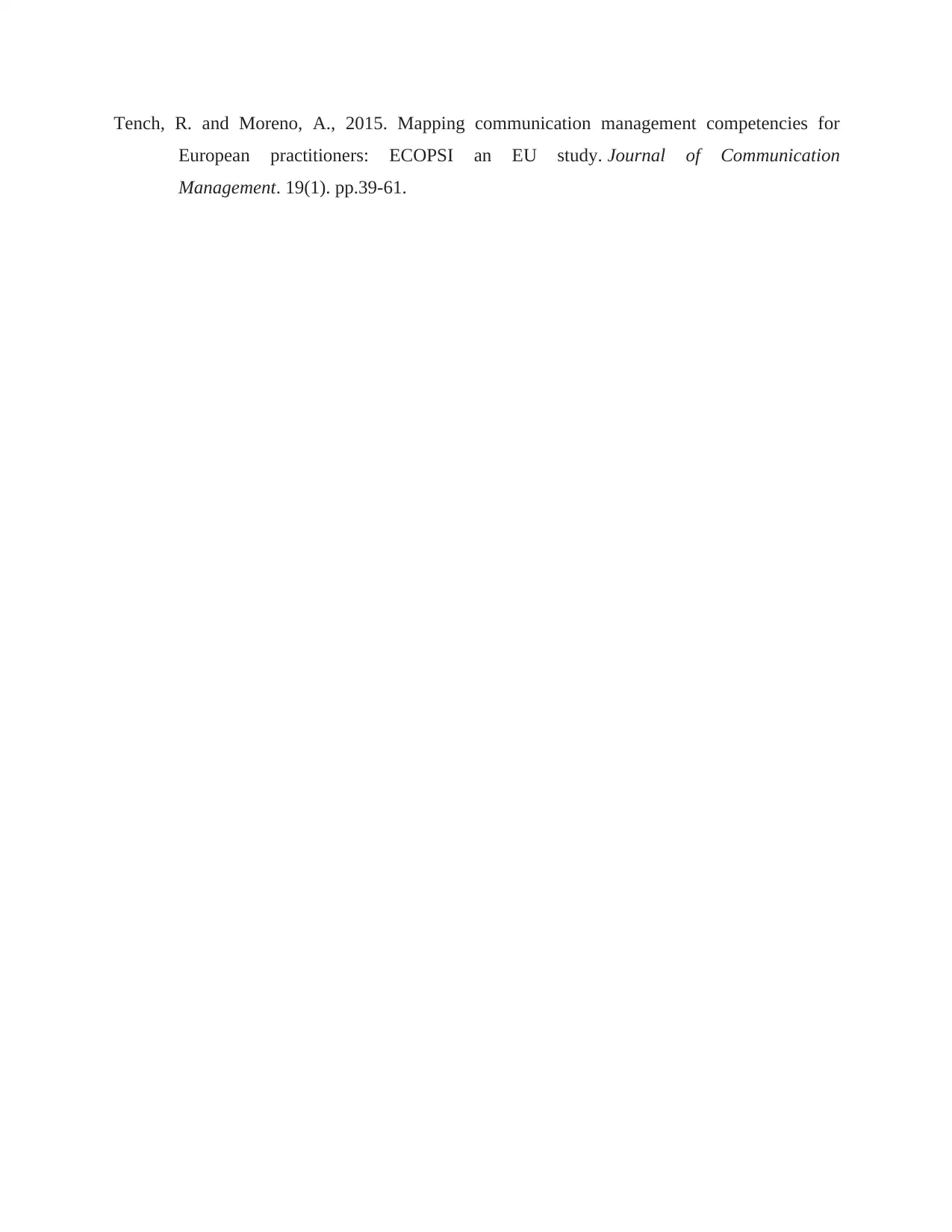
Tench, R. and Moreno, A., 2015. Mapping communication management competencies for
European practitioners: ECOPSI an EU study. Journal of Communication
Management. 19(1). pp.39-61.
European practitioners: ECOPSI an EU study. Journal of Communication
Management. 19(1). pp.39-61.

1 out of 10
Related Documents
Your All-in-One AI-Powered Toolkit for Academic Success.
+13062052269
info@desklib.com
Available 24*7 on WhatsApp / Email
![[object Object]](/_next/static/media/star-bottom.7253800d.svg)
Unlock your academic potential
© 2024 | Zucol Services PVT LTD | All rights reserved.





